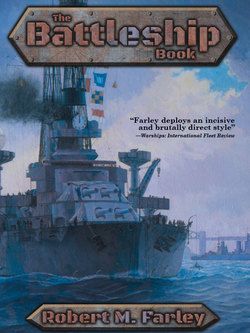Читать книгу The Battleship Book - Robert M. Farley - Страница 20
На сайте Литреса книга снята с продажи.
ОглавлениеDante Alighieri
Laid Down: 1909
Launched: 1910
Completed: January, 1913
Displacement: 19,500 tons
Main Armament: twelve 12” guns (four triple turrets)
Secondary Armament: sixteen 4.7” guns (twelve individual mounts, two twin turrets)
Speed: 22 knots
Major Actions: None
Treaty: Pre-Washington Naval Treaty
Fate: Scrapped, 1928
Naming a battleship is fraught with complication. A capital ship is more than just a weapon; it represents national power in its purest and most visible form. Names, therefore, carry with them deep political and symbolic implications. Warship names sometimes send a message to foes, but they just as often speak to domestic audiences.
The various navies of the world used different protocols to name their battleships. The United States Navy was probably the most programmatic; battleships were to be named after states, cruisers after cities, destroyers after people, submarines after fish, and aircraft carriers after famous battles. (This has changed in recent years.) The Kriegsmarine named its battleships after former monarchs, great admirals, and German states. The Royal Navy took names from all manner of different sources, including great battles (Agincourt), military commanders (Nelson, Marlborough, Iron Duke), monarchs (Queen Elizabeth), and famous old ships (Dreadnought). The Soviets changed the names of all of Russian battleships to suitably revolutionary terms after 1920, then changed them back during World War II. Only the Italians seem to have named a battleship after a poet.
[no image in epub file]
RN Dante Alighieri. Dr. Dan Sangera
Dante Alighieri was the first Italian dreadnought, and one of the first battleships anywhere to carry its main armament in triple turrets. The disposition of the turrets (four down the centerline, but not superfiring) gave Dante Alighieri a particularly heavy broadside for her 19,500 ton displacement. However, her end-on fire amounted to only three guns on either side. Only the Americans trusted the idea of superfiring turrets enough to attempt it on their first dreadnoughts. Like many Italian warships, Dante could make a good speed (23 knots) but sacrificed protection.
RN Dante Aligheri, line drawing. Brassey’s Naval Annual 1923.
Dante Alighieri had a relatively uneventful career. Designed to counter the dreadnoughts of the Austro-Hungarian Navy, Dante patrolled a great deal but never saw battle, as the Austrian ships rarely left port. The newer Italian battleship Leonardo Da Vinci wasn’t so lucky, being blown up either by Austrian saboteurs or by an Italian ammunition accident in 1917. Italian frogmen replied by sinking the Austro-Hungarian battleship Viribus Unitis just after it had been transferred to the new Yugoslav Navy in 1918.
Dante Alighieri survived the war, but not the peace. Dante and all of the other Italian dreadnoughts (including a refloated Leonardo Da Vinci) remained legal under the terms of the Washington Naval Treaty. Although the Regina Marina went to the trouble of putting her through a major reconstruction in 1923, it was clear that she would need another major modification in order to compete with the modernized super-dreadnoughts of the Royal Navy. Consequently, she was taken out of commission and sold for scrap in 1928.
RN Dante Alighieri
Author’s Note
Italian naval architecture is often dramatically underrated. The refusal to use superfiring turrets was a major problem with this design, but Dante Alighieri could make an impressive 22+ knots. The Austria Tegetthoffs (with superfiring triple turrets) had slightly more armor, but a lower speed and considerably less stability. In a line-of-battle engagement, Dante would have performed more than adequately.
The scrapping of Dante (and the failure to return Leonardo Da Vinci to service), meant that the Regia Marina would enter the 1930s understrength by two dreadnoughts. Given the dramatic transformations Italy worked upon its surviving dreadnoughts, there’s little question that her naval architects would have been able to transform Dante into a useful unit. However, as Italy discovered in World War II, it simply lacked the material and economic resources to operate a major fleet for an extended period of time, meaning that even a modernized Dante likely would have sat an anchor for most of the war.
Related Entries:
Preceded… Giulio Cesare
Meant to fight… Viribus Unitis
Contemporary of… SMS Ostfriesland
